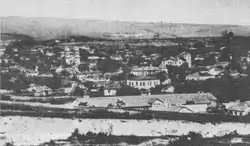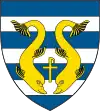Babadag
Babadag (Romanian pronunciation: [babaˈdaɡ] ⓘ; Turkish: Babadağ, lit. "Father Mountain"), formerly known as Babatag,[3] is a town in Tulcea County, Romania, located on a small lake formed by the river Taița, in the densely wooded highlands of Northern Dobruja. One of the several tombs of Sari Saltik is found in town.
Babadag | |
|---|---|
 | |
 Coat of arms | |
 Location in Tulcea County | |
 Babadag Location in Romania | |
| Coordinates: 44°53′53″N 28°44′31″E | |
| Country | Romania |
| County | Tulcea |
| Government | |
| • Mayor (2020–2024) | Georgian Caraman[1] (PNL) |
| Area | 121 km2 (47 sq mi) |
| Highest elevation | 120 m (390 ft) |
| Lowest elevation | 15 m (49 ft) |
| Population (2021-12-01)[2] | 9,213 |
| • Density | 76/km2 (200/sq mi) |
| Time zone | EET/EEST (UTC+2/+3) |
| Postal code | 825100 |
| Area code | (+40) 02 40 |
| Vehicle reg. | TL |
| Website | www |
The Babadag Lake is divided only by a strip of marshland from Razim Lake, a broad landlocked sheet of water spilling into the Black Sea.
History

The name of Babadag is connected with 13th century dervish Baba Sari Saltik, who is said to have led a number of Turkomans to Dobruja and to have settled them in this area. The town was first mentioned by Ibn Battuta under the name Baba Saltuk, as the furthermost outpost of the "Turks" (i.e., the Golden Horde).[4]
The town was conquered by Bayezid I, sultan of the Ottoman Empire, in his 1393 Danubian campaign. The construction of a fortress was begun here in 1633 during the reign of Murad IV, but by 1650 only the fortress's foundation walls and towers were standing. In the 17th century, it occasionally served as the winter headquarters for the Grand Vizier of the Ottoman Empire during their wars with Russia.[3] The town's location near to the Black Sea made it a target for the Russian navy, the town was bombed by the Russians in 1854 during the Crimean War.[3] In the mid-19th century, Babadag formed part of the region (sanjak) of Silistra within the "Bulgarian Government" (Danube Vilayet).[3] Following the 1877–1878 war between the Ottoman and Russian empires, Babadag became part of independent Romania.
At Babadag, the Romanian Army operates a military training facility. With a total surface area of 270 km2 (100 sq mi), this is one of the largest and most modern training firing ranges in Europe. In 2008, United States Army forces started to train at Babadag as part of Romania's integration into NATO.[5] In 2022, units of the 101st Airborne Division (that has returned to Europe for the first time since World War II) have been training at the Babadag base, near the border with Ukraine.[6]
Demographics
| Year | Pop. | ±% |
|---|---|---|
| 1912 | 4,686 | — |
| 1930 | 4,626 | −1.3% |
| 1948 | 4,022 | −13.1% |
| 1956 | 5,549 | +38.0% |
| 1966 | 7,343 | +32.3% |
| 1977 | 8,564 | +16.6% |
| 1992 | 10,437 | +21.9% |
| 2002 | 10,878 | +4.2% |
| 2011 | 8,940 | −17.8% |
| Source: Census data | ||
In 1900 Babadag population was 3,500.[7] The 2011 census counted 8,940 inhabitants.
Population distribution:
- 6,267 Romanians (77.64%)
- 420 Turks (5.2%)
- 1248 Horahane Roma (15.46%)[8]
- 37 Lipovans (0.45%)
- 98 Others
84.8% were Romanian Orthodox and 14.2% Muslim.
Economy
Before the First World War, Babadag served as the market for wool and mutton from the Dobruja.[7]
Natives
- Laurențiu Iorga (born 1988), footballer
- Kemal Karpat (1924–2019), historian and professor at the University of Wisconsin–Madison
- Aurel Toma (1911–1980), professional boxer
Notes
- "Results of the 2020 local elections". Central Electoral Bureau. Retrieved 15 June 2021.
- "Populaţia rezidentă după grupa de vârstă, pe județe și municipii, orașe, comune, la 1 decembrie 2021" (XLS). National Institute of Statistics.
- EB (1878).
- Stănciugel et al., p.44-46
- "Romania–US Army Training". Archived from the original on 18 July 2008. Retrieved 16 July 2008.
- Crăciunoiu, Adrian; Oanță, Ovidiu (24 October 2022). "După 78 de ani, Divizia istorică 101 Aeropurtată a Armatei SUA a revenit în Europa. Cum se antrenează în România". Pro TV (in Romanian). Retrieved 29 October 2022.
- EB (1911).
- Mentalities and social changes in the multiethnic communities of the Romanian post-communism uaic.ro, PhD Thesis
References
- Baynes, T. S., ed. (1878), , Encyclopædia Britannica, vol. 3 (9th ed.), New York: Charles Scribner's Sons, p. 178.
- Chisholm, Hugh, ed. (1911), , Encyclopædia Britannica, vol. 3 (11th ed.), Cambridge University Press, p. 91.
External links
![The Gazi Ali Pasha Mosque [ro]](../I/RO_TL_Geamia_Ali-Gazi_Pa%C8%99a_din_Babadag.JPG.webp) The Gazi Ali Pasha Mosque
The Gazi Ali Pasha Mosque Park in Babadag
Park in Babadag Northern access road
Northern access road Black Sea Rotational Force Marines and Romanian soldiers at the Babadag Romanian Army Training Area
Black Sea Rotational Force Marines and Romanian soldiers at the Babadag Romanian Army Training Area
